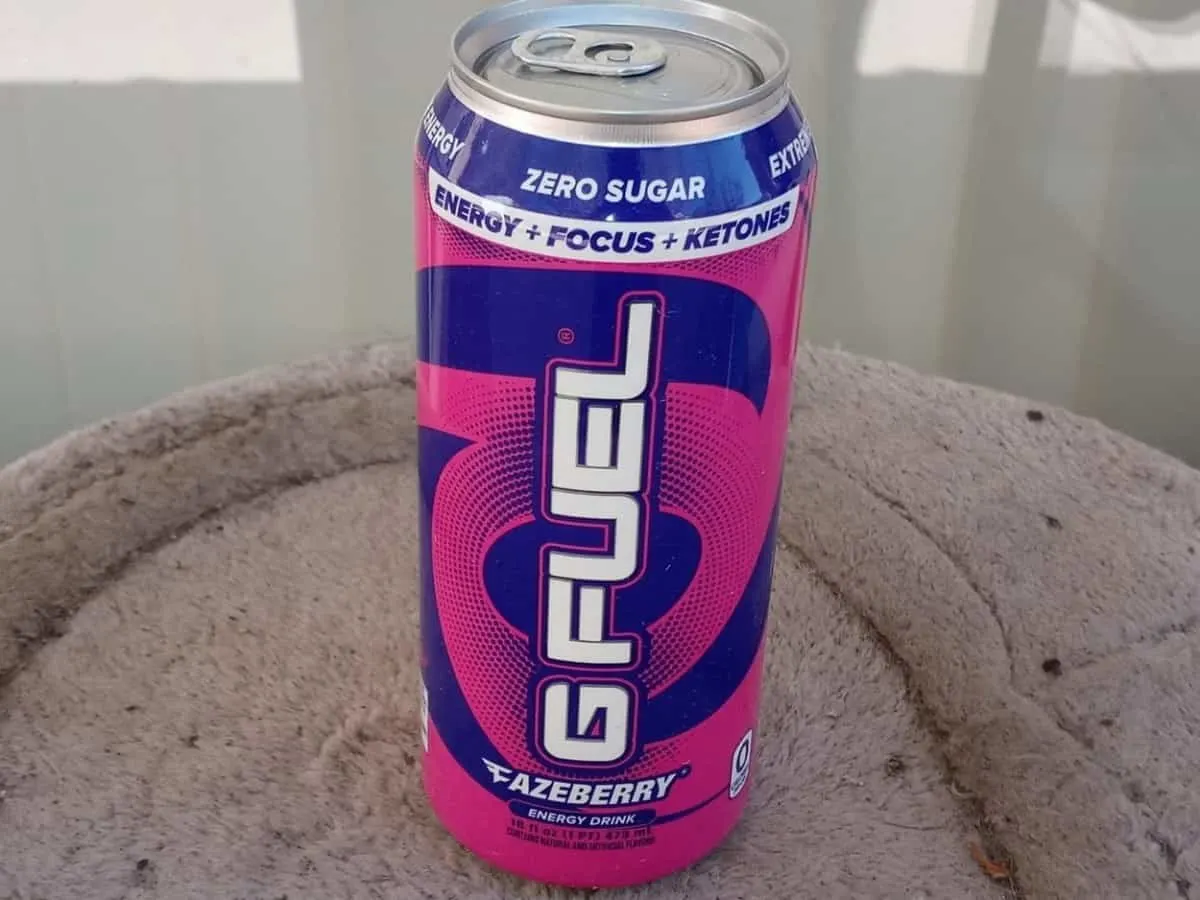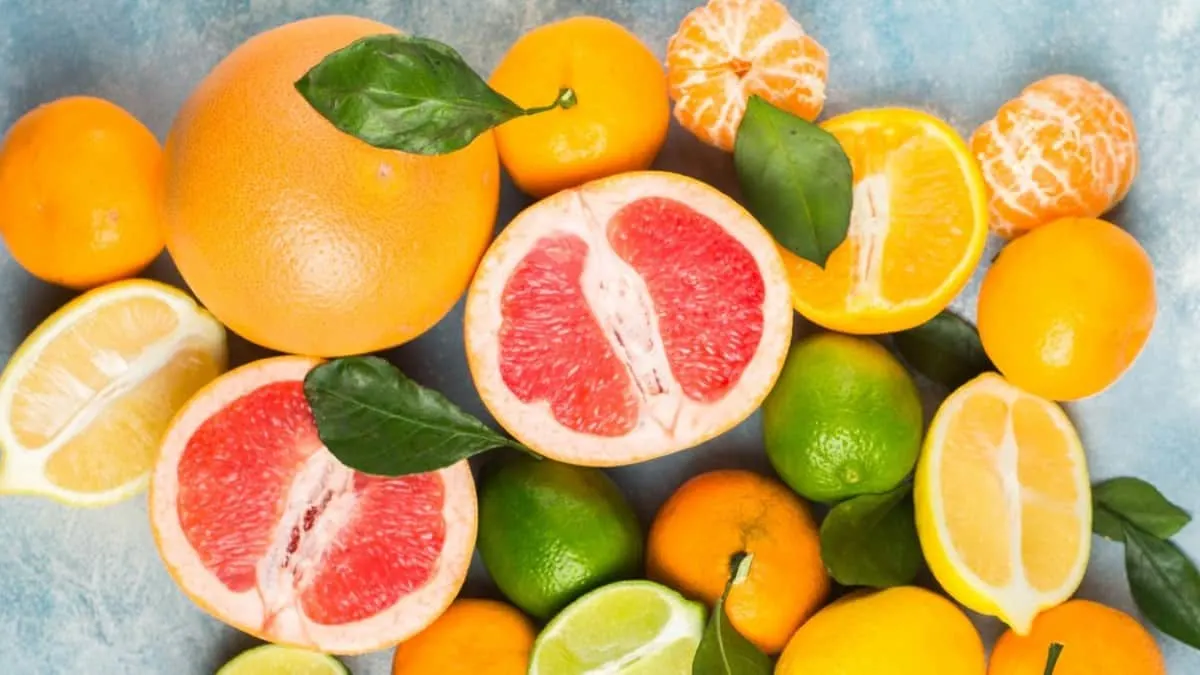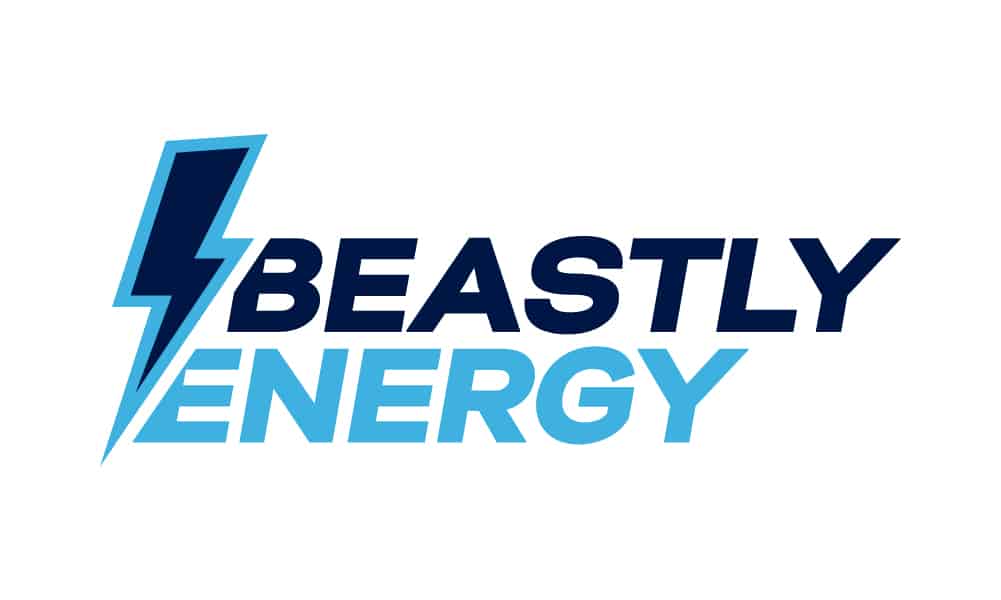Ever wondered how different the G Fuel powder formula is from its can version?
One look at the nutrition facts label, and you’ll notice the caffeine content a single can has. It might seem the same with its powder version, but there’s more to it when you compare the two.

Does the difference make G Fuel cans a bad alternative compared to its powdered version?
Although the G Fuel cans have twice the amount of caffeine the powder variant has, it has zero sugar, which is good for those who are looking to lessen their intake of sweetened products.
How is this possible?
First, let’s look into the nutritional facts found on the label.
Contents
G Fuel Can Nutrition Facts
| Nutrient | Amount per Serving (16 fl.oz) |
| Calories | 0 |
| Total Carbohydrates | 0g |
| Sugar | 0g |
| Sodium | 70mg |
| Protein | 0g |
| Potassium | 85mg (2%) |
| Niacin (Vitamin B3) | 4mg (25%) |
| Vitamin B6 | .04mg (25%) |
| Vitamin B12 | .06mcg (25%) |
| Vitamin C | 45mg (50%) |
| Caffeine | 300mg |
To clarify, the percentages represent the percent daily value (%DV). %DV is normally used when referring to vitamins and minerals the body gets from each serving of food or beverage. They’re calculated based on the assumption that you follow a 2000 calorie per day diet.
Like with many other things, vitamins and minerals have recommended limits too. It’s okay to overlook these guidelines when it comes to water-soluble vitamins, but for everything else, let’s say sugar, can lead to terrible consequences.
By that I mean, you can overdose on sugar and experience health problems paired with a bad diet and zero exercsie.
Nutritional labels exist to help you avoid that. They tell you how much of your daily need for a nutrient you fulfill by having one serving of the product.
Looking at what you’re getting from the food and drink you buy can be a big help in making informed decisions about what you eat and drink.
Do G Fuel Cans Use Artificial Sweeteners?
G Fuel Cans are sugar-free. Instead, they get their flavor from artificial sweeteners like sucralose and Acesulfame Potassium (Ace-K).
Artificial sweeteners are a kind of sugar substitute. Companies use them in their formulas to add flavor to their products without bringing sugar into their products. Artificial sweeteners can also be sold on their own as baking ingredients or food additives.
This is done to make the product marketable to people who either can’t eat sugar (e.g diabetics) or want to cut down on calories. Thanks to that, sugar-free products are popular with both.
Despite what it sounds like, artificial sweeteners are actually sweeter than sugar. For example, sucralose is 600 times sweeter than sugar while adding little to no calories to the food or drink it was used on.
These aren’t without their downsides though. Ace-K and Sucralose are both been linked to health issues, however, the studies we have so far are inconclusive.
Likewise, Ace-K has been tied to weight gain while Sucralose is suspected to cause imbalances in gut bacteria your body needs to stay healthy.
How Much Caffeine is in G Fuel Can?
A can of G Fuel has 300mg of caffeine.
Caffeine can give you the energy you need during the day. However, too much of it can also lead to negative circumstances.
It gets worse when you remember that the recommended daily caffeine limit is 400mg for adults.
So drinking a can of G Fuel will fill 75% of your daily caffeine limit. That means if you also consume other sources of caffeine like chocolate and tea within the same day, you could very easily end up with too much caffeine in your system.
The side effects of drinking too much caffeine are:
- Insomnia
- Headache
- Anxiety
- Irritability
- Twitching/Muscle tremors
- Palpitations
- Frequent urination
Among all of these, insomnia is the most noteworthy one in my opinion. Besides making you crabby, not getting enough sleep can also slow your reaction time and the cognitive functions (e.g attention span) you need to function at work.
That shouldn’t necessarily be a deal-breaker though. 300mg is a lot on paper, but people with a high tolerance for caffeine might not be so negatively impacted by drinking it.
300mg can also be incorporated into your diet by minimizing how much of the other caffeine sources you consume on the days you drink G Fuel.
Another good option would be to just drink one can when you need it so you can have more leeway when it comes to other food and drinks for the rest of the week.
G Fuel Can Ingredients
According to the back of the can, these are the ingredients you can find in G Fuel:
- Carbonated Water
- Natural Flavors
- Artificial Flavors
- Sodium Gluconate
- Malic Acid
- Caffeine
- Potassium Beta-Hydroxybutyrate
- Maltodextrin
- Vitamin C
- Vitamin B3
- Vitamin B6
- Vitamin B12
- L-Tyrosine
- Sucralose
- Potassium Citrate
- Citric Acid
- Acesulfame Potassium
- Green Coffee Bean Extract
- Green Tea Extract
- Turmeric Extract
- Tart Cherry
- Blueberry
- Broccoli
- Kale
- L-Theanine
- Steviol Glycosides
On the label, some of the ingredients are listed as groups.
Maltodextrin, Vitamin B3, Vitamin B6, and Vitamin B12 make up the Vitamin blend. These are the synthesized versions of the nutrients your body needs for a boost in its metabolism.
The Antioxidant blend represents the ingredients Gamma Labs included in the formula to ease the strain your body is under. These are:
- Green Coffee Bean Extract
- Green Tea Extract
- Turmeric Extract
- Tart Cherry
- Broccoli
- Kale
Other ingredients to remember are the artificial sweeteners and properties that are also in the powder variant’s focus complex. An example of the latter would be L-Tyrosine.
Antioxidants in G Fuel Cans

As mentioned, the antioxidants in the can version of G Fuel are the ones in the Antioxidant Blend. Most of them are fruit and other kinds of plant extracts since they are natural sources of antioxidants.
Besides that, Vitamin C and Vitamin E are good antioxidants.
Antioxidants are important in your body since they fight free radicals. Free radicals are the reactants in the oxidation reactions that happen in your body. They also make good preservatives and are used as such in the food industry.
Without antioxidants, you could end up with too many free radicals in your system. This state wherein free radicals outnumber the antioxidants in the body is called oxidative stress. In the worst-case scenario, that might cause you to develop health problems like diabetes, heart disease, and cancer.
Besides the lack of antioxidants, oxidative stress can also be caused by an individual’s living conditions and lifestyle.
Environments and practices that put you at risk of oxidation stress are:
- Air Pollution
- Smoking
- Drinking excessively
- High blood sugar levels
- Infections (viral, bacterial, or fungal)
- Excessively taking vitamin C and vitamin E
- Intense and prolonged exercise
However, according to a certain study, energy drinks aren’t a consistent source of antioxidants you can rely on to stay healthy.
So yes, you still need to keep a balanced diet to maintain an overall healthy body.
Sodium Gluconate in G Fuel Cans
Sodium Gluconate is a chelating agent and cleaner in food and industrial use. It can also be a nutrient, but that’s much less common.
A chelating agent is a substance that helps ions and molecules bond with metal ions. Despite that, it can actually serve many different purposes when used in food.
Sodium Gluconate plays a big role when used as a food ingredient such as:
- Keeping unwanted metal ions out by chelating them
- Increasing pH levels
- Reducing the bitterness from artificial sweeteners like Ace-K
- Increasing meat’s water-binding capacity so it’s firmer and more sliceable
Like in the food industry, Sodium Gluconate serves as a pH adjuster and buffer. You can find it in syrups and hard capsules.
You can also find it in cosmetics in the form of personal care products.
Do G Fuel Cans Work?
G Fuel is a great alternative for people who want to avoid drinking coffee. It has adequate amounts of nutrition to get you started for the day. However, it’s not advisable for those who are below 18 years old, pregnant, and nursing women, including those who are sensitive to caffeine.
Although children and adolescents aren’t totally incapable of processing caffeine properly, they are more vulnerable to the side effects than an adult is.
That means drinking too much caffeine from any source can result in having high blood pressure and experiencing sleep problems.
The American Academy of Pediatrics (AAP) suggests being cautious of how much caffeine any minor consumes in a day. To be specific, parents and guardians should ensure that their children consume no more than 100mg a day — just a third of what you get from a can of G Fuel.
Here’s a video tackling on the hospitalization and death of a teenager that drank too much caffeine. According to the report, he collapsed after drinking a soft drink, an energy drink, and coffee within a 2 hour period.
It also opens up about children who are drinking coffee and how it could affect their central nervous when overdosed on caffeine. That’s why they should limit their daily caffeine intake to 100mg.
Are There Side Effects to G Fuel Cans?
It’s common to get side effects from taking excessive amounts of certain food and drinks, especially with energy drinks. As mentioned, any caffeinated beverage is discouraged for specific people.
But for everyone else, having G Fuel can in a day is perfectly safe. You can have G Fuel can as you please without worrying about side effects so long as you don’t exceed your caffeine tolerance for the day.
Final Thoughts
In general, G Fuel cans are safe to drink considering that most of its ingredients are water-soluble.
G Fuel can contain 300mg of caffeine, no sugar, and very few calories. So unless you’re sensitive to artificial sweeteners or any of the other ingredients, caffeine is the only thing you really need to worry about.
This also means that if you’re in one of the groups of people who shouldn’t be near energy drinks, stay clear of it, period.
There are many other energy drinks that are just as good if G Fuel isn’t for you. If it really has to be G Fuel, I’d recommend going for the powder version instead. The powder variant has half the caffeine compared to its can version, which has more caffeine but more flavors to choose from.
Personally, I’d only take this version of G Fuel if I badly needed the boost. 300mg of caffeine may be well within your tolerance, but considering that it’s worth 3 cups of coffee, it’s better to be safe than sorry.
Then again, there’s no rule that says you can’t dilute an energy drink to get that extra push without overdosing on caffeine.
If none of the above is an issue for you, then the G Fuel can is definitely a good addition to the brand lineup. It’s good for people who live busy and fast-paced lifestyles that the normal sources of caffeine (and their prices) can’t keep up with thanks to the vitamins and very high caffeine content.
It’s good for people who are trying to cut down on their calorie and sugar intake too. So if that’s your priority, G Fuel cans can be a solid option for something that’ll give you an extra push without the unwanted calories.
Other Articles
For other references about G Fuel cans, check out this article on G Fuel’s Nutrition Facts:
